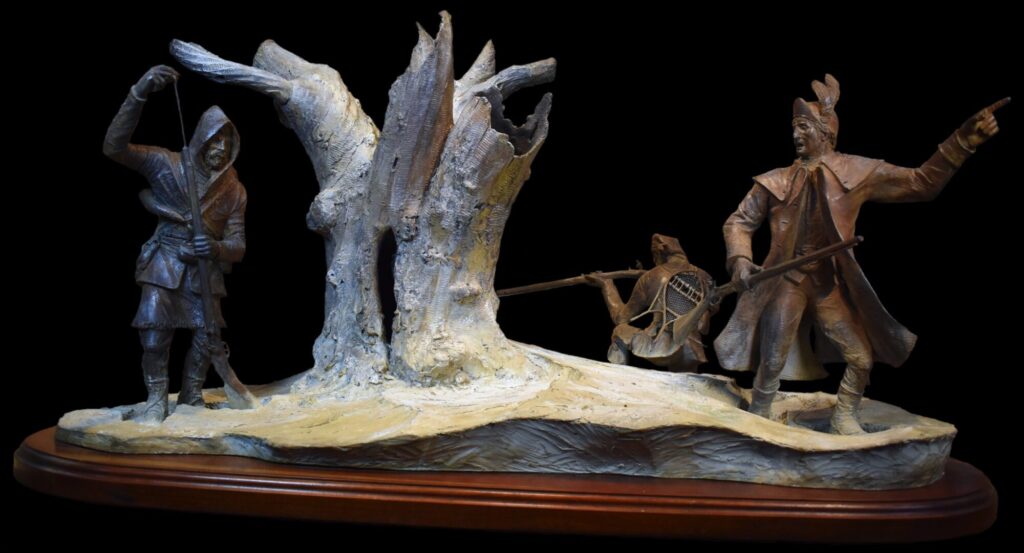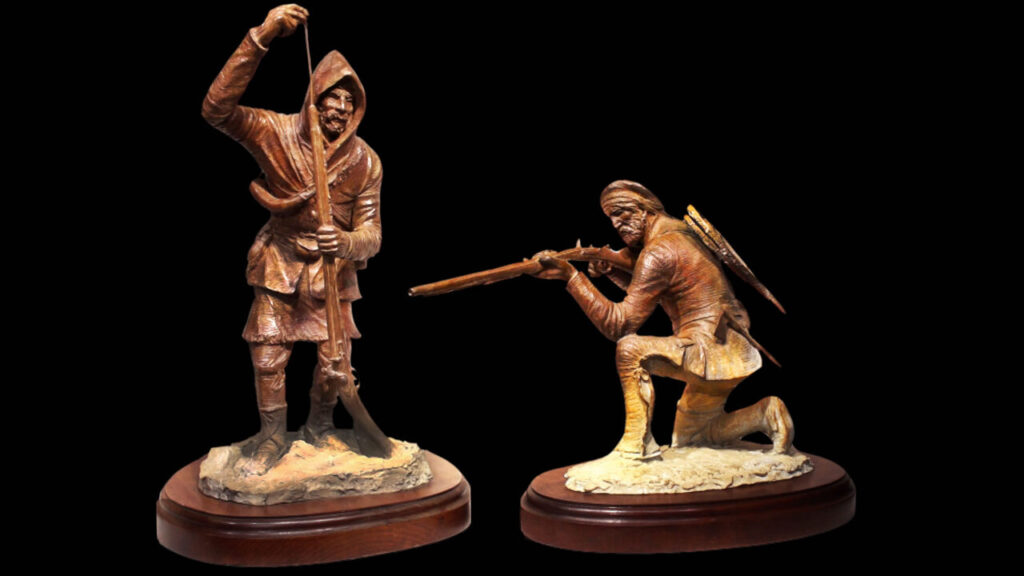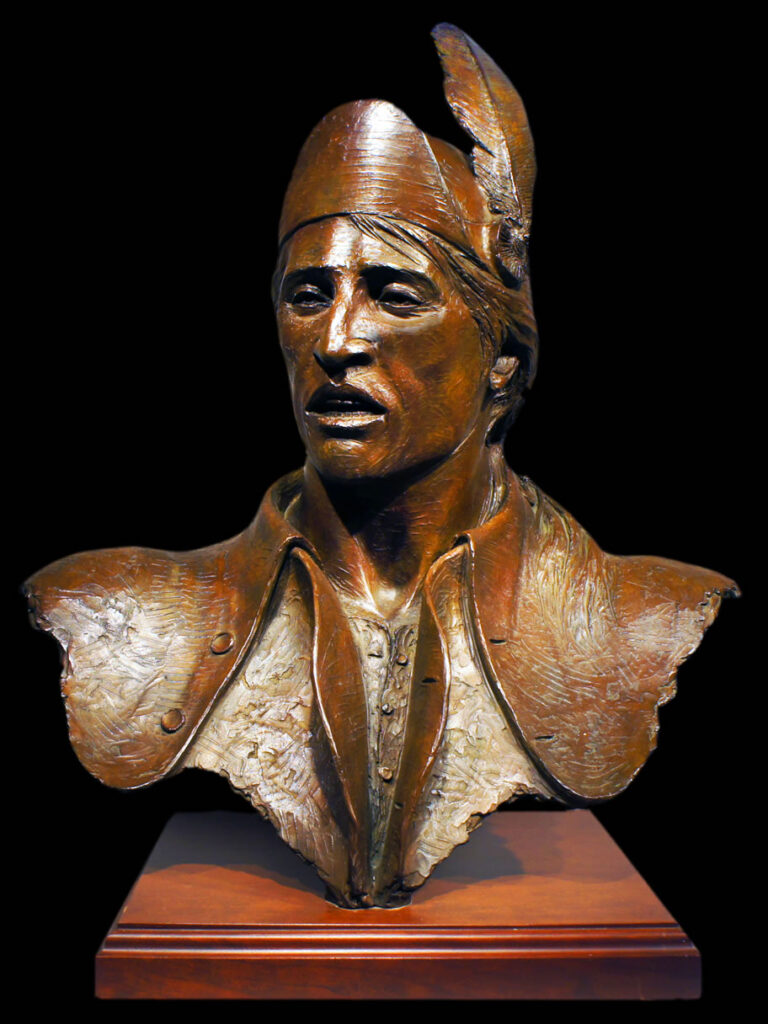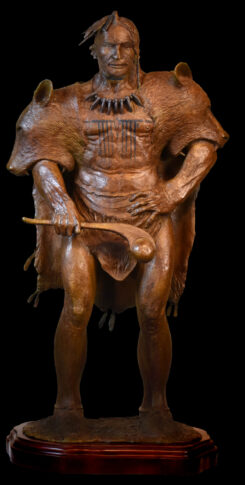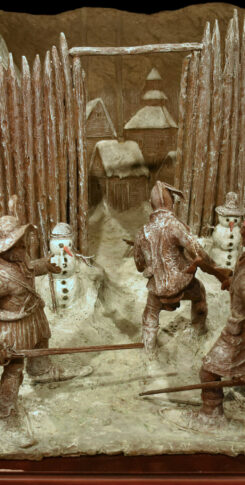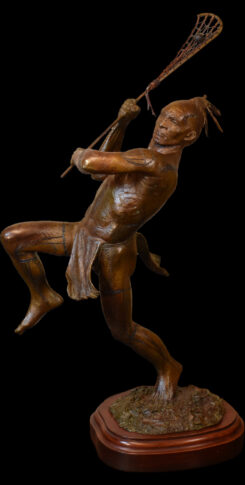2005 | Bronze edition: 20 | Maximum Height: 32″ | Maximum Width: 28″ | Length: 50 “
One of the most famous battles of the French and Indian War, Robert Rogers turns one of his only defeats into a “victory” through clever public relations and by exaggerating both the enemies strength and the number of casualties inflicted. He thus further enhances his already legendary reputation. His nemesis is the most famous of the Canadian partisan fighters the Sieur Jean – Baptiste Leverault de Langis de Montergron (a.k.a. Langy).
March 1758: Rogers leads 180 rangers on a scout north toward Ft. Carillon (Ticonderoga) behind enemy lines. There are 4′ of snow on the ground. Along the west side of Bald Mountain near Lake George, they discover below them a force of about 100 Indians and a few French under the command of the Sieru de la Durantaye heading south on the frozen Trout Brook. The Rangers open fire killing about 40 of the enemy. They pursue them back up the brook but run headlong into the musket fire of Langy’s more than 200 men. Up until this terrible awakening, they were unaware of Langy’s force. They were caught completely by surprise. The withering fire and savage counter attack leaves 50 Rangers dead. Rogers shouts orders to fall back to higher ground. The battle now rages for 90 minutes until dusk when, just before they are completely surrounded, Rogers orders the survivors to scatter and meet at the agreed upon rendezvous place. Accounts vary but no more than 35-55 of the original 181 Rangers survive. The French will claim 145 scalps taken. Carillon’s commandant Hebecourt reports: “We had a wonderful result but it cost us dearly through the loss that we suffered.”
Two Rangers, Capt. Pringle and Lt. Roche retreated into the gathering darkness: “After marching all night, daylight showed us a place we were unacquainted with. Here we saw a man who was a servant of Capt. Rogers…we thought ourselves fortunate in meeting with a guide to whom we gave entire confidence. We had no blanket or coat…our snowshoes breaking and we sinking to our middle every 50 paces, scrambling up mountains, across fallen timbers, our nights without sleep or covering…our sustenance…the berries and bark of trees. The wind piercing us like a sword together with a freezing rain that encrusted us entirely with ice. In crossing a stream we were plunged entirely into the water…we then made a path around a tree and exercise all night, though scarce able to stand, (to keep from freezing to death)…the 18th brought us to the [lake shore] yet still do I dread the consequence and with reason, for the first light informed us it was the very place we had left 5 days before…our guide staggered from us and sat down and died immediately. (Here I must own that my resolution began to leave me.) We had no resource but to throw ourselves in the enemies hands or perish.”
Pringle’s account to Col. Haviland dated Carillon March 28, 1758
Find more about Robert Rogers escape at The Legend of Rogers Rock on the Major Robert Rogers sculpture page where there is also more information on Rogers himself.
Robert Rogers most lasting contribution was to offer an alternative to the standard European military tactics that did not work in the rugged, heavily forested terrain of America – as the 1755 defeat of Gen. Braddock’s army clearly demonstrated. By adapting the fighting techniques of the Indians, including a heavy emphasis on marksmanship, Rogers inspired the creation of the first light infantry companies and his Rangers were the forerunners of all special forces that followed. His 29 Ranging Rules that he codified in 1757 are still issued to U.S. special forces today and remain posted at Ranger battalion headquarters at Ft. Benning, Georgia.
“Like Durer’s Knight, a ghastly death stalked at their side. There were those among them for whom this stern life had a fascination that made all other existence tame.”
(description of the men who became Rogers Rangers)
from “Wolfe and Montcalm” by Francis Parkman, 1884

